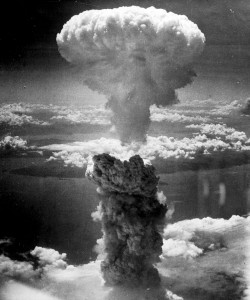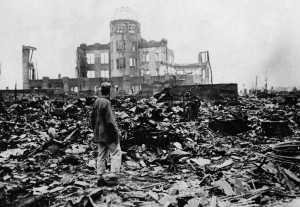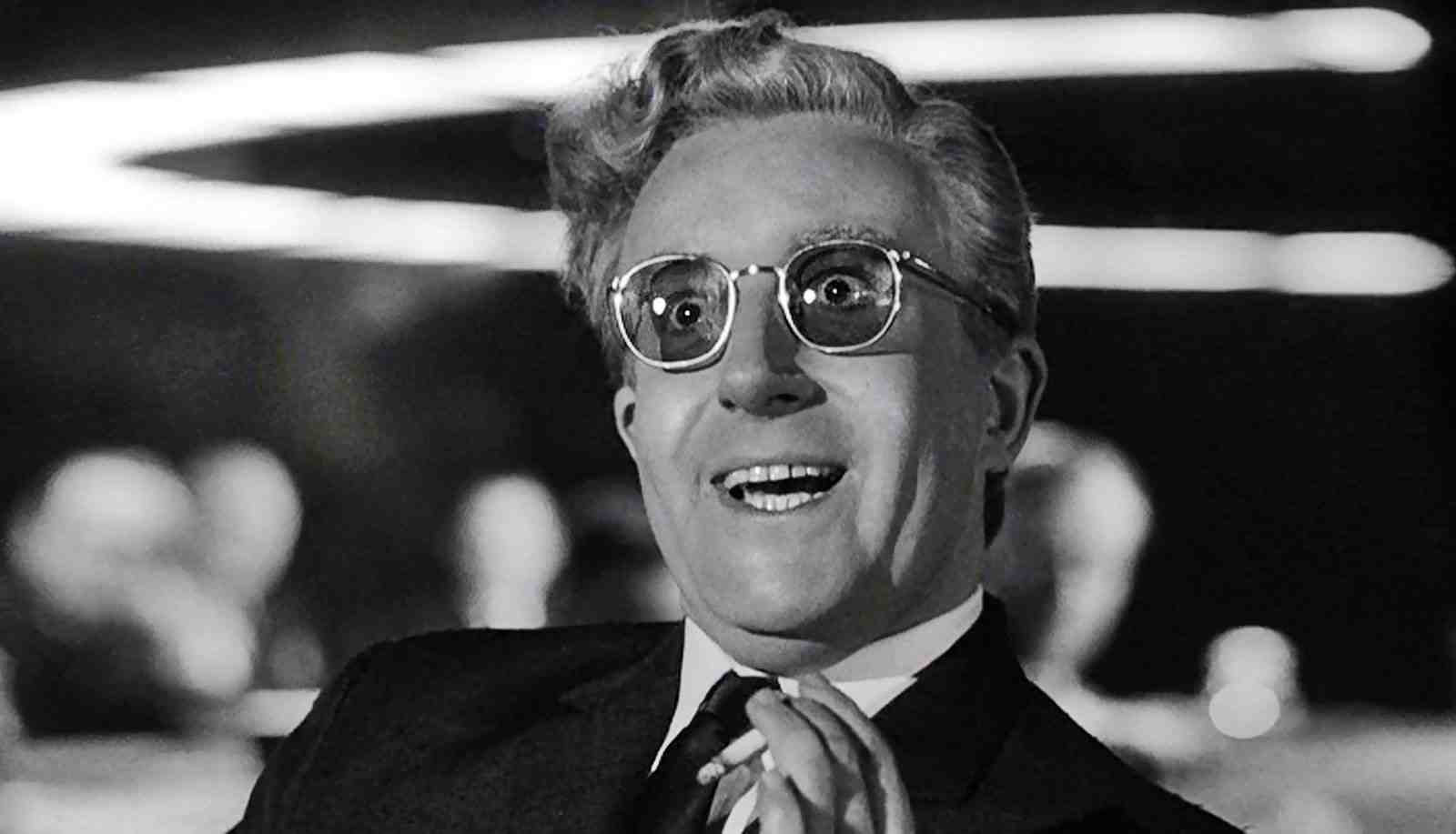A secular “myth of progress” teaches that, just as science has grown in knowledge, and just as technology has become more and more advanced, society is also becoming more enlightened, moving in a definite, desirable direction. The advance of science seems to be correlated with the withdrawal of religion. Therefore, as progress marches on religion and tradition will retreat, and reason will triumph over superstition. But is this myth truly mythological? After all, Steven Pinker’s The Better Angels of Our Nature uses a blistering storm of graphs and charts to demonstrate that science, rationalization and education have made the world a safer, more peaceful place.
In Pinker’s defence, it is true that a “Long Peace” followed the Second World War; since 1945 no two major powers have met on the battle field. We might assume that this is because they would not dare to: the threat of nuclear war makes the cost unbearably high. Pinker disagrees; “the threat of nuclear annihilation deserves little credit for the Long Peace” (p. 268). He points out that small states (North Korea, Afghanistan, Vietnam) were not deterred from challenging nuclear powers. He also believes nuclear weapons were never used because here was a moral “taboo” against using them; it was not fear of escalation that prevented their use, but a moral sense that the horrors of Hiroshima must not be repeated. Pinker also argues that the major powers were deterred by the threat of conventional war, not nuclear war.
This is, of course, pure nonsense. It is true that both West and East were too exhausted to fight another World War in the late 1940s and early 1950s. In “The Cold War” historian Jeremy Black notes that even Stalin was wary of pushing the Russian people too far during this period. However, from the mid-1950s Western military planners relied on:
“…notions of graduated nuclear retaliation through the use of ‘tactical’ (short range) nuclear weapons in association with conventional forces, based in Western Europe, complemented by a policy of developing an effective intercontinental retaliatory strike capability, in order to make it too dangerous to risk an attack on the USA. ( p.97)
For better or worse, and for the remainder of the Cold War, nuclear weapons were the only weapons preventing Warsaw Pact forces  from controlling Europe. “There was, in fact, no other way to defend Western Europe from a Warsaw Pact that by the 1980s boasted more than fifty infantry and armoured divisions, 16 000 tanks, 26 000 fighting vehicles and 4 000 combat aircraft” (Tondy Judt, Postwar, p.590). Soviet numerical superiority meant that the Warsaw Pact had little to fear from Western conventional forces. Given the longstanding Soviet desire to force NATO out of Berlin we have no reason to think that the Long Peace could have lasted in the absence of a nuclear deterrent.
from controlling Europe. “There was, in fact, no other way to defend Western Europe from a Warsaw Pact that by the 1980s boasted more than fifty infantry and armoured divisions, 16 000 tanks, 26 000 fighting vehicles and 4 000 combat aircraft” (Tondy Judt, Postwar, p.590). Soviet numerical superiority meant that the Warsaw Pact had little to fear from Western conventional forces. Given the longstanding Soviet desire to force NATO out of Berlin we have no reason to think that the Long Peace could have lasted in the absence of a nuclear deterrent.
Did a moral taboo prevent politicians from using nuclear weapons? Or was the universal horror of the bomb based on rational calculations about the costs of nuclear war? During the Berlin Wall crisis, both General Maxwell Taylor and Assistant Secretary of Defence Paul Nitze proposed that Kennedy fight a rational nuclear war, with limited nuclear strikes against key Soviet bases to bring about a rapid victory. President Kennedy listened to their arguments, but neither he nor Defence Secretary McNamara were convinced that a first strike could achieve total victory, or that a President could keep control of the armed forces in a nuclear exchange (Sabato, The Kennedy Half Century, pp. 92-96).
In other words, moral scruples about “The Bomb” did not stop Americas leaders from attacking the USSR; they avoided conflict with Russia because they feared that any exchange of nuclear weapons would quickly spiral out of control. Indeed, fear of Soviet military retaliation in Europe prevented America from using the atom bomb in Korea and Vietnam. The threat of nuclear war even halted wars between small states. Famously, during the Yom Kippur war Israel was prevented from pressing into Syria and Egypt when the Soviets threatened to act unilaterally to defend their allies. Kissinger put the US forces on a global nuclear alert and Nixon pressured the Israelis into accepting a ceasefire (Taylor and Downing, Cold War, p.334).
Where does this leave the Long Peace? In Pinker’s own words: “[i]f the Long Peace were a nuclear peace, it would be a fool’s paradise, because an accident, a miscommunication, or an air-force general obsessed with his precious bodily fluids could set off an apocalypse (p.268)”. These scenarios are not as far-fetched as they sound. During the Watergate scandal President Nixon became depressed, emotionally unstable, and began to drink heavily. Secretary of Defence Schlesinger felt compelled to order the head of the Joint Chiefs of Staff to seek his approval before acting on any launch order from the President (Schlosser, Command and Control , p. 360). The paranoid and elderly Andropov tended to see NATO plots were none existed (ibid, 2013, p.446-448).
 To take one example of the many false alarms which took place during the Cold War: on June 3rd 1980, shortly after the Soviet invasion of Afghanistan, National Security Adviser Zbigniew Brzezinski was awoken to be told that the Soviet Union had launched over 2000 missiles at North America. As bomber crews prepared to invade the USSR and missile crews began to access launch codes, the Pentagon realised that a computer error was responsible, and that no attack was underway (Schlosser, 2013, p. 367-378).
To take one example of the many false alarms which took place during the Cold War: on June 3rd 1980, shortly after the Soviet invasion of Afghanistan, National Security Adviser Zbigniew Brzezinski was awoken to be told that the Soviet Union had launched over 2000 missiles at North America. As bomber crews prepared to invade the USSR and missile crews began to access launch codes, the Pentagon realised that a computer error was responsible, and that no attack was underway (Schlosser, 2013, p. 367-378).
Dramatic retellings of the actions of Kruschev and Kennedy during the Cuban missile crisis create an illusion of control; we assume that politics alone determined the outcome of the crisis. In fact, several events could have precipitated a war accidentally. For example, October 27, 1962, while America was on DEFCON 3, Major Charles Maultsby’s U2 plane got lost collecting air samples above the North Pole. He strayed into Siberian air-space, and Soviet fighters were scrambled to intercept. US fighters, equipped with air-to-air atomic missiles, were sent to protect Maultsby back to safety. Under the rules of engagement, the pilots could fire their atomic weapons at the Soviet fighters under their own authority (Schlosser, 2013, p. 462-463).
As for rational politics, when General George Lee Butler took over as head of the Strategic Air Command in January 1991, just at the end of the Cold War, he decided to review SIOP (Single Integrated Operational Plan, the name given to America’s nuclear war plan from 1960 to 2003). His conclusion?
With the possible exception of the Soviet nuclear war plan, this was the single most absurd and irresponsible document that I had ever reviewed in my life…I came to fully appreciate the truth…we escaped the Cold War without a nuclear holocaust by some combination of skill, luck and divine intervention, and I suspect the latter in greatest proportion” (Schlosser, 2013, p. 457).
Pinker also fails to notice that Europe remained stable during the Long Peace due to the massive ethnic cleansing which took place at the end of the Second World War (Mark Mazower,Dark Continent , 217-224; Timothy Snyder, Bloodlands, p.313-338). We should add that if governments have not killed quite so many people during the Long Peace, it is not for want of trying. America, famously, dropped over one million tonnes of explosives on North and South Vietnam; as terrible as the onslaught was, there would have been many more casualties if Vietnam has not been primarily an agricultural society without large urban targets.
In the last half century, we have gone to extraordinary efforts to perfect the art of killing. If only 14% of the civilian and military personnel employed in the US Army are in combat positions, it is because high-tech warfare requires a large support complement to hit its targets both effectively and accurately. Firepower comes at a massive financial cost: the war in Iraq cost America 200 billion dollars in 2003-4 alone (Parker, The Cambridge History of Warfare , p. 429). America’s gargantuan military budget is necessary both to train a “warrior elite” and to develop the technologies which compensate for the West’s numerical inferiority. Can we really claim the world is less violent if nations must go to such lengths to defend themselves?
Of course scientific progress has been a tremendous gift to the human race; only a fool would be nostalgic for an era before antibiotics and anaesthetics. Furthermore, modern science is partially due to Christian world-view; so a Christian would be ill-advised to argue that science is intrinsically dangerous. But scientific progress could face severe practical obstacles which cannot be answered by scientific methods. Science cannot rewrite human nature. While it might enhance human capabilities one day, humans will still act in whatever way seems best to them…The very power that scientific progress has brought to society makes that society vulnerable. We can now devour resources and destroy life at unprecedented rates. Simply reflect on the power that scientific progress put in the hands of a Soviet nuclear submarine commander during the Cuban missile crisis. If we ignore the anarchy that reigns in the human heart, the very power of scientific discovery could bring scientific progress to a terrible end.

